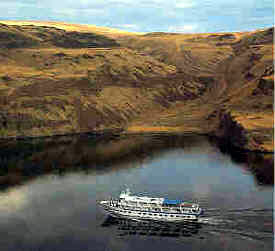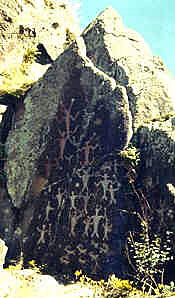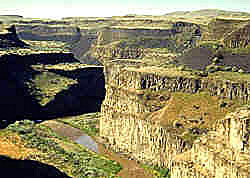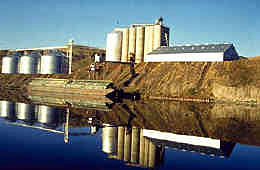Travel
Search
ON THE TRAIL OF
|
|
Harlan Hague
The Lewis and Clark Expedition has excited the imagination of Americans for almost two hundred years. President Thomas Jefferson instructed the two United States Army officers to search for a water route though the continent and learn as much as they could about the unknown interior. During their trek from the Mississippi River to the Pacific coast and back again in 1803-1806, the expeditionary force roughly paralleled the courses of the Snake and Columbia rivers. Their journals describe a three-year journey of hardship and foul weather, particularly on the lower Columbia. Our journey, by contrast, was a delight, relaxing and educational, and good weather all the way.We boarded the M/V Sea Lion in mid-May at Portland's Riverplace Marina on the Willamette River. The 152' ship, constructed and registered in the United States, would be our home for the next week as we followed in the wake of Lewis and Clark by ship, jet boat, and zodiac. The ship's shallow draft and bow thrusters permit the Sea Lion to go where most cruise ships turn back. Cabins are comfortable, and all are outside. Dress in the lounge and dining room is informal, and all passengers can be accommodated in one seating at meals. Indicative of the nature of the cruise, the ship's staff included a historian, a geologist, and a naturalist. No social director. During cruising, one or more of the staff were always on deck, commenting and pointing out sights along the bank. They led walks ashore as well. As we cruised down the Willamette to its confluence with the Columbia, thence up the
latter, Carlos Schwantes, noted historian of Lewis and Clark and A few miles upstream from Portland is Bonneville Dam. From the dam to a point above the confluence of the Snake River, the Columbia, properly speaking, is a series of artificial lakes. The same can be said for the Snake. From its mouth to Lewiston and Clarkston, two Washington cities that straddle the river at the Idaho border, the Snake is a stair-stepped lake. In the course of our cruise up the Columbia and the Snake, we passed through locks at eight dams, with a combined lift of 726 feet. The 105-foot vertical lift at John Day is the largest in the world. The lock gate of 700 tons looks like a guillotine for giants. Most locks employ the more common miter doors, which open and close like the two doors of a formal dining room. Long before the arrival of Lewis and Clark, the river was home and gathering place. We
saw petroglyphs The ship's staff geologist often commented on the geologic origins of the region. Huge sedimentary boulders, mudstone or shale, at the water's edge on the upper Columbia were deposited here by moving continental plates about 100 million years ago. Several layers of volcanic basalt are revealed in the walls of the gorge. Cliffs of columnar basalt that sweep up from the water's edge are particularly striking. The severe aspect of the gorge is often softened by hills, some rolling, some sharp and craggy, that appear covered with green velvet. At Clarkston on the Snake, we transferred to jet boats for an exciting ride into Hells Canyon. The desert canyon is reputedly the deepest in North America. The boats glided across rapids and bounced over rolling white water. On one occasion passengers were thrilled to see wild bighorn sheep on ledges high above the river. Five minutes later, our driver brought the boat quietly into the shallows to watch bighorns grazing at the bank. We had a pleasant buffet lunch on the lawns of the headquarters of the Hells Canyon National Recreation Area. There are no roads here, a questionable disadvantage. The site can be reached only by water. Turning downstream now, we rejoined the Sea Lion and soon anchored inside the
mouth of the Palouse River, which flows into the Columbia from the Returning to the river, we boarded zodiacs and cruised upstream. Uplake, actually. The Palouse at its mouth is part of the lake formed by a Columbia dam. Reeds and marshes harbored an abundant bird life. In a short stretch of river (lake), we saw orioles, meadowlarks, red-winged blackbirds, hawks, belted kingfishers, Caspian terns, gulls, Canada geese, and lots of swallows flying about their adobe nests clinging to the cliff face and fetching mud at the riverbank. We saw two beaver lodges, but no beaver. Our zodiac finally reached the head of the lake and the beginning of the free-flowing Palouse River. The stream, about twenty feet wide, was too swift and probably too shallow for the zodiacs, and we turned back. The chocolaty flow mixed gradually with the clearer blue-green water of the lake. One morning, we were bussed to the heights of Rowena Plateau for a panoramic view of the gorge of the Columbia. We continued inland through the beautiful Hood River Valley to Parkdale. The view of tidy spring-green orchards, with snow-capped Mt. Hood rising above them, was captivating. At the historic Parkdale Grange hall, we were treated by local people to coffee and tea and forced to choose between half a dozen kinds of homemade pies. The mixed berry was delicious. So was the apple. For our return, we boarded vintage coaches of the Hood River Railroad. Half way down the valley, in order to negotiate a steep slope, the train slowed to a halt at a dead end, then rolled backward through a switch and down a connecting track. The remainder of the journey was made in reverse. It seems that this technique was cheaper to build than cutting switchbacks on the hillside. Back aboard the Sea Lion, we continued down the Columbia and passed a stretch of
river that is mecca for wind-surfers. The upstream winds here are strong and reliable.
Later the ship tied up at Bonneville Dam We were blessed with uncommon weather at the mouth of the Columbia: bright sunshine, cloudless sky, little wind. Lewis and Clark never had it so good. A director of the Columbia River Maritime Museum at Astoria gave us a personal tour of this world-class facility. Later We toured Fort Clatsop, a careful reconstruction of the expedition's 1805-1806 winter lodging. The diarists complained bitterly that the weather was cold and debilitating, the rain constant. We had sunshine and balmy breezes. On our last evening, we anchored near the shore between the Columbia's mouth and Portland. I stood at the rail at dusk, watching the sun set. A Canada goose swam into view near the ship, followed by a perfect file of fifteen tiny goslings, followed by another adult. A fitting end to a memorable trip. To investigate the attractions of the Columbia River, call the Oregon Tourism Division, (800) 547-7842, and Columbia River Gorge National Scenic Area, (503) 386-2333. For information on the Portland area, contact the Portland Oregon Visitors Association, (503) 222-2223. Plan to spend an hour or two at the beginning of your visit in the exhibits of The Oregon History Center, 1200 S.W. Park Avenue, Portland, (503) 222-1741. For information on the seven-day voyage described here, contact Special Expeditions, Inc., 720 Fifth Avenue, New York, NY 10019, 800/762-0003. |
|
Caveat and disclaimer: This is a freelance travel article that I published some time ago. Some data, especially prices, links and contact information, may not be current. |
|
|
|
|
 the Pacific
Northwest, presented an overview of the Lewis and Clark expedition, particularly pointing
out where our course would touch theirs. On the afternoon of the first day, we debarked
for a bus excursion, choosing between a visit to the Columbia Crest Winery or a birding
walk in the McNary Wildlife Refuge.
the Pacific
Northwest, presented an overview of the Lewis and Clark expedition, particularly pointing
out where our course would touch theirs. On the afternoon of the first day, we debarked
for a bus excursion, choosing between a visit to the Columbia Crest Winery or a birding
walk in the McNary Wildlife Refuge.  on rocks just above the water's edge that speak of ancient
inhabitants. Representations of human figures with what appear to be antennae have led to
interesting speculation about the artists. Melancholy abandoned farmsteads of more recent
date suggest a lonely existence. A child's swing hanging from a branch of an ancient apple
tree spoke volumes.
on rocks just above the water's edge that speak of ancient
inhabitants. Representations of human figures with what appear to be antennae have led to
interesting speculation about the artists. Melancholy abandoned farmsteads of more recent
date suggest a lonely existence. A child's swing hanging from a branch of an ancient apple
tree spoke volumes.  Washington side. Zodiacs ferried us to a waiting bus that took us to Palouse Falls and its
deep, sharply-etched canyon. Usually clear and blue, the water at the falls was the color
and consistency of thick chocolate, attesting to erosion from heavy rains in the high
country.
Washington side. Zodiacs ferried us to a waiting bus that took us to Palouse Falls and its
deep, sharply-etched canyon. Usually clear and blue, the water at the falls was the color
and consistency of thick chocolate, attesting to erosion from heavy rains in the high
country.  ,
where we toured
the visitor center and watched salmon and other species swimming through the underwater
viewing windows of the fish ladder. We returned to the ship and cruised downstream,
enjoying the waterfalls that tumble from the heights on the Oregon side.
,
where we toured
the visitor center and watched salmon and other species swimming through the underwater
viewing windows of the fish ladder. We returned to the ship and cruised downstream,
enjoying the waterfalls that tumble from the heights on the Oregon side.